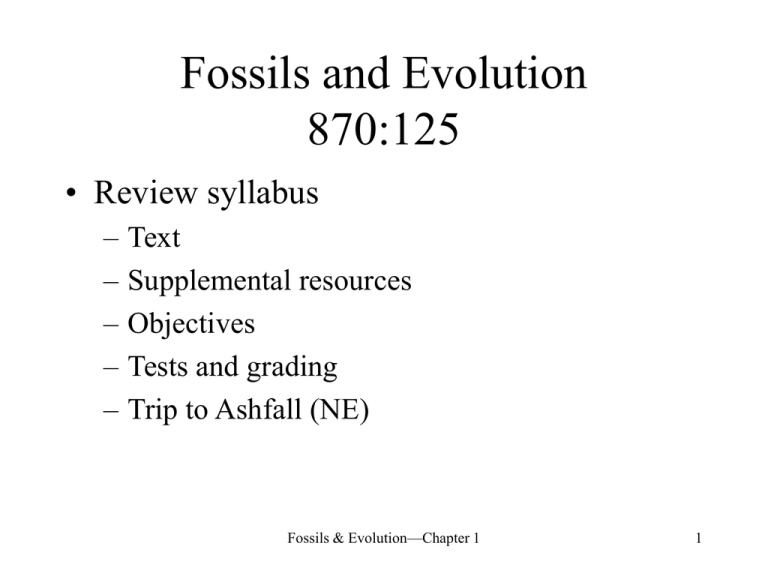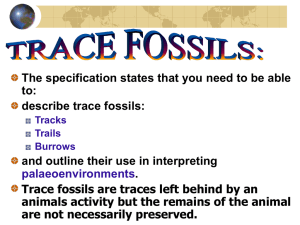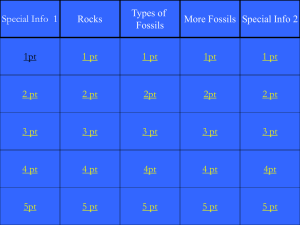Chapter 1 Preservation and the fossil record
advertisement

Fossils and Evolution 870:125 • Review syllabus – – – – – Text Supplemental resources Objectives Tests and grading Trip to Ashfall (NE) Fossils & Evolution—Chapter 1 1 Ch. 1—Key concepts to know • The fossil record is incomplete. Biological, mechanical and diagenetic agents all destroy potential fossils. • Normal fossil preservation is favored by rapid burial of durable hard parts. • Exceptional preservation occurs via rapid burial in finegrained sediments under low oxygen conditions. • The fossil record is biased because of differential preservation and uneven sampling. It is biased in favor of: 1) durably skeletonized organisms; 2) marine organisms; 3) geologically recent organisms • Because of biases, knowledge of past life is far better at higher taxonomic levels than at lower taxonomic levels Fossils & Evolution—Chapter 1 2 Key terms (know definitions) • • • • • • • Taphonomy Biocenosis Thanatocenosis Necrolysis Biostratinomy Diagenesis Lagerstätten Fossils & Evolution—Chapter 1 3 Why study fossils? • Fossil = remains or traces of a once-living organism • Paleontology = the study of fossils • Importance of paleontology – – – – – Biostratigraphy (age dating of rocks) Evolution Paleoecology/paleoenvironmental interpretation Paleogeography/paleobiogeography Simple fascination Fossils & Evolution—Chapter 1 4 Modes of preservation 1. Unaltered remains (frozen mammoths; insects in amber; unaltered shells & bones) 2. Permineralization (infilling of void spaces) 3. Replacement (molecule by molecule substitution) 4. Impressions 5. Carbonization 6. Molds / casts Fossils & Evolution—Chapter 1 5 Eocene mammal with partially preserved fur and flesh (Germany) Carbonized Jurassic leaf Fossils & Evolution—Chapter 1 6 Taphonomy = science of fossilization • Many steps in the process of fossilization, with significant removal of specimens at every step • Once fossilized, the odds of being collected are low (uplift and exposure; weathering; discovery; chance, etc.) Life assemblage (biocenosis) Necrolysis (scavenging, decay) Death assemblage (thanatocenosis) Biostratinomy (break-up, scattering and shallow burial of remains) Initial fossil assemblage Diagenesis (deep burial, recrystallization, dissolution, metamorphism, etc.) Fossils & Evolution—Chapter 1 Final fossil assemblage 7 Life assemblage (biocenosis) Destruction of most soft tissues Death assemblage (thanatocenosis) Destruction of most hard tissues Total fossil assemblage Destruction of most fossils Fossils actually discovered Fossils & Evolution—Chapter 1 8 Quality of the fossil record • The fossil record is highly biased – Number of fossils is but a fraction of the number of once-living plants and animals Fossils & Evolution—Chapter 1 9 Fossilization is a rare event! • Some estimates: – > 4,500,000 living species of plants and animals – 250,000 described fossil species – Thus, all described fossil species represent < 5% of the total number of living species – Yet, fossil record covers billions of years and today’s biota is but a snapshot – If preservation were truly efficient, then number of fossil species should dwarf number of extant species Fossils & Evolution—Chapter 1 10 Standing crop in ¼ m2 (offshore Japan) ½m •197 shells (~ 200) •Average lifespan = 2 years, thus:……… •1000 empty shells in 10 years •100,000,000 empty shells in 1 m.y. •A stack of shells 1000 m high if a layer of 1000 shells is 1 cm thick (actual sedimentary thickness is ~320 m/m.y.) ½m Fossils & Evolution—Chapter 1 11 Sources of bias • Uneven preservation potential • Sampling bias Fossils & Evolution—Chapter 1 12 Uneven preservation potential • Preservation potential of organisms is goverened by – Resistance to destruction • Biological, mechanical, chemical • Hard parts vs. soft parts – Habitat (during life) Fossils & Evolution—Chapter 1 13 Destruction • Biologic destruction includes – – – – Predation Scavenging Boring Bacterial decay Example: Radiograph of heavily bored gastropod Fossils & Evolution—Chapter 1 14 Destruction • Mechanical destruction includes breakage and abrasion due to particle interactions caused by wind, waves, currents – Some shells and bones are more resistant to abrasion and breakage than others – Different sizes of the same shells vary in their resistance to abrasion and breakage Fossils & Evolution—Chapter 1 15 Abrasion experiment (multitaxa) gastropod coral alga coral gastropod Fossils & Evolution—Chapter 1 16 Abrasion experiment (marine bivalves) large shells small shells Fossils & Evolution—Chapter 1 17 Durability of vertebrate bones • Durability is governed by bone density and thickness; also by surface area-to-volume ratio: – Least durable • Ribs, vertebrae, breastbone, hip (part), shoulder blade, fingers, toes – Intermediate • Thigh, shin, upper and lower arms, ankles and wrists, hip (part) – Most durable • Teeth, jaws, skull Fossils & Evolution—Chapter 1 18 Destruction • Chemical destruction varies with: – the original skeletal mineralogy of a fossil – the chemistry of subsurface fluids – temperature of burial environment Fossils & Evolution—Chapter 1 19 Relative chemical stability <-- low stability fossil groups radiolarians diatoms sponges calcareous algae calcareous forams mollusks cnidarians opaline silica aragonite high stability --> hi-Mg calcite low-Mg calcite most oysters ?? ?? apatite (CaPO4) organic tabulates rugosans scleractinians stromatoporoids echinoderms brachiopods bryozoa arthropods conodonts vertebrates graptolites dinoflagellates pollen/spores Fossils & Evolution—Chapter 1 20 Destruction • Chemical stability vs. temperature and pressure – Silica is more stable in cold water – Carbonate is more stable in warm water and under low pressures • Dissolution occurs under high pressure and low temperature conditions Fossils & Evolution—Chapter 1 21 Distribution of modern deep sea pelagic sediments Fossils & Evolution—Chapter 1 22 Resistance to destruction • Hard parts are much more likely to be preserved than soft parts (but soft parts and even pigments can be preserved) Fossils & Evolution—Chapter 1 23 Environment and preservability • Best preservation generally occurs in calm, aquatic environments • Exceptional preservation occurs in finegrained sediments in the absence of oxygen, (“biologically inert” burial conditions) Fossils & Evolution—Chapter 1 24 Environment and preservability • Lagerstätten (“Mother lode”) = deposits that contain large numbers of unusually well preserved fossils – – – – – – Burgess Shale (Cambrian, Canada) Hunsrück Shale (Devonian, Germany) Mazon Creek Shale (Pennsylvanian, Illinois) Solnhofen Limestone (Jurassic, Germany) Baltic amber (Oligocene, Germany) La Brea tar deposits (Pleistocene, California) Fossils & Evolution—Chapter 1 25 Lagerstätten (Hunsrück Shale, Devonian of Germany) Fossils & Evolution—Chapter 1 26 Lagerstätten (Solnhofen Limestone, Germany) Fossils & Evolution—Chapter 1 27 Lagerstätten (Burgess Shale, Cambrian of Alberta) Fossils & Evolution—Chapter 1 28 Tully monster (Mazon Creek Shale, Pennsylvanian of Illinois) Check out U-Haul website http://www.uhaul.com/supergraphics/tully/the_graphic.html Fossils & Evolution—Chapter 1 29 Sampling bias • Fossil record is best in most recent geologic systems – Younger rocks are less likely to be covered or obscured by other rocks – Younger rocks are less likely to have been eroded, metamorphosed or subducted Fossils & Evolution—Chapter 1 30 Fossil species diversity vs sediment volume/exposure Fossils & Evolution—Chapter 1 31 Consequences of preservation and sampling bias • Knowledge of past life is far better at higher taxonomic levels than at lower taxonomic levels – In a given sample, you’d only need to look at a small number of specimens to find all of the phyla present, but you’d have to look at a lot of specimens to find all of the species present! Fossils & Evolution—Chapter 1 32 Sampling bias: Danish Miocene mollusks Phyla Classes Orders Families Genera Species Individual shells Fossils & Evolution—Chapter 1 1 3 12 44 64 86 2,954 33 Sampling bias: Danish Miocene mollusks • If sample size were larger, then more species and possibly more genera might have been found, but probably no more classes or phyla • If sample size were smaller, then fewer genera and species would have been found, but probably no fewer classes or phyla Fossils & Evolution—Chapter 1 34 Rarefaction curve [How many taxa would have been found had the sample been smaller?] Fossils & Evolution—Chapter 1 35 Conclusions • Every assemblage of fossils represents an extremely biased sample of the organisms once living in an area • Lack of fossils in a rock cannot be taken to mean that organisms were not living in the area – “Absence of evidence is not evidence of absence” Fossils & Evolution—Chapter 1 36









